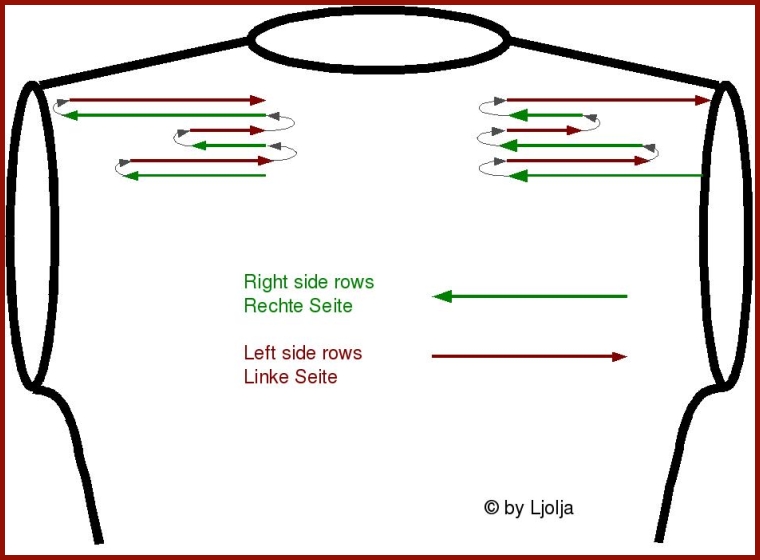Die Anzahl der Maschen für die Schulter durch 3 teilen, falls die Zahl sich nicht ohne Rest teilen lässt, den Rest zum Drittel, welches näher am Ausschnitt ist, dazurechnen (Beispiel: 31=Schulterbreite, 31:3=10+1, also werden die Maschen folgendermaßen aufgeteilt 10,10,11). Falls man nach Anleitung strickt, braucht man sich über die Zahlen keine Gedanken zu machen, sondern nimmt einfach die, die fürs Abketten an den Schultern vorgesehen sind. Anschließend werden die Schultern den errechneten Zahlen entsprechend laut Schema in verkürzten Reihen gestrickt, wobei an den Wendestellen die Maschen - wie bei Sockenfersen - umwickelt werden sollten, um Löcher zu vermeiden. Die Maschen werden hinterher nicht abgekettet, sondern verweilen auf einem Maschenhalter, bis Front(en) und Rückenteil fertig sind. Diese werden nun mit den rechten Seiten nach innen zusammengelegt und an den Schultern zusammen abgekettet. Diese Technik nennt sich Three Needle Bind-Off. Wie es genau geht, kann man sich bei knittinghelp anschauen. Ich hoffe, dass meine Ausführungen verständlich und nützlich sind. Wer einmal diese Technik ausprobiert, wird die Schulterpartie nie wieder anders stricken - garantiert!

There are a lot of factors which make up a lovely sweater or cardigan. Most of them depend on your personal preferences. But some can help you on the way to a beautiful garment regardless of its colour, shape or the yarn you use. Short row shoulder shaping is one of these essentials factors. Unfortunately most patterns don't even mention this technique but mostly tell you to cast off the top of the shoulders in three steps and to seam front and back. I prefer to knit the shoulders this way:
Divide the number of shoulder stitches into three equal parts. If this is not possible, add the remainder to the part nearest to the neck (Example: 31 shoulder stitches, 31:3=10+1, so you would split the stitches into parts of 10, 10 and 11). If you are using a pattern, you don't need to care about the numbers but can use those given in the instructions. Start to knit short rows according to these numbers as shown in the sketch wrapping the turn stitches. After you have finished the short rows, don't cast-off the stitches but put them on a stitchholder until front(s) and back are completed. Hold front and back together right sides facing each other and work a three needle bind-off. Knittinghelp offers a great video tutorial for this technique. I hope my explanations make sense. If you try this way of shoulder shaping, you will wonder how you could do without before - I promise!
Divide the number of shoulder stitches into three equal parts. If this is not possible, add the remainder to the part nearest to the neck (Example: 31 shoulder stitches, 31:3=10+1, so you would split the stitches into parts of 10, 10 and 11). If you are using a pattern, you don't need to care about the numbers but can use those given in the instructions. Start to knit short rows according to these numbers as shown in the sketch wrapping the turn stitches. After you have finished the short rows, don't cast-off the stitches but put them on a stitchholder until front(s) and back are completed. Hold front and back together right sides facing each other and work a three needle bind-off. Knittinghelp offers a great video tutorial for this technique. I hope my explanations make sense. If you try this way of shoulder shaping, you will wonder how you could do without before - I promise!



1 Kommentar:
Klasse! Bitte mehr von solch guten Tipps und genialen Graphiken! Ingrid
Kommentar veröffentlichen